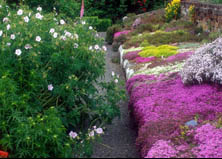Snowdrops and snowflakes

The woods around Chesters Walled Garden are full of snowdrops at the moment, great undulating sweeps of them stretching away amongst the bare trunks of beech trees. Within the walled garden itself there are more snowdrops, as well as some specials such as the gorgeous, large snowdrop, Galanthus plicatus. It's a pity that the cold, windy weather is stopping early bees from benefitting from all the bounty. Other plants are in flower: sky-blue Scillas, spotted Hellebores in varying shades of pink and deep maroon, fragrant Viburnum farreri, rosemary in the greenhouse, fat buds on the protected peach tree and out in the garden, the lovely pointed bells of snowflakes.
I love their vibrant green, less bluey than the leaves of snowdrops, and the little green points on their old fashioned-lampshade shaped flowers. These are spring snowflakes, Leucojum vernum, yet there are already some sporadic flowers on the taller, so named summer snowflake, Leucojum aestivum. A seemingly odd name this as it always flowers about March or April but it was named by Linnaeus for whom it bloomed much later in Sweden.
Gardens in other parts of the world have been delighting us on Sundays with Monty Don's Around the World in 60 Gardens series. The most memorable for me have been the ones that widen my concept of gardens - the floating gardens of South America, the organic vegetable plots on derelict land in Havana or great sweeps of prairie grasses. I found it particualry interesting that in the last programme, from America, the two gardens that I loved the most were the two most modern and yet at opposit ends of the design spectrum - James van Sweden's fenland meadow and the stunning Californian house and garden.


